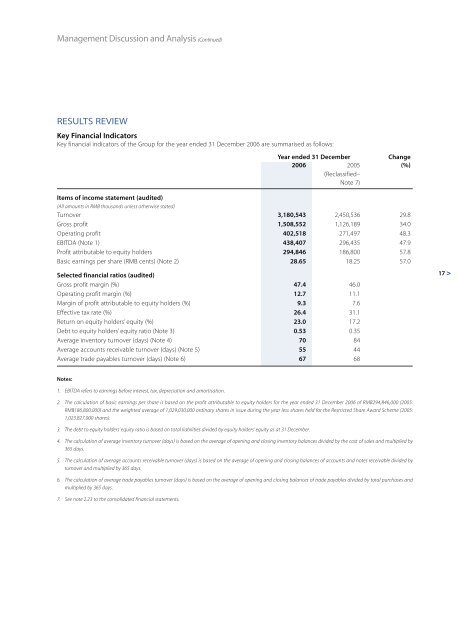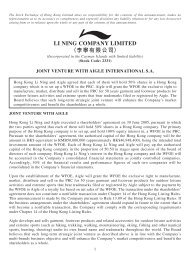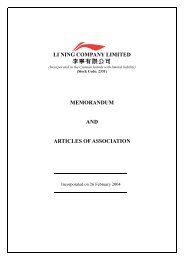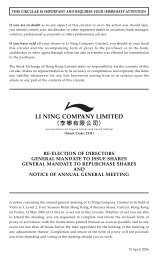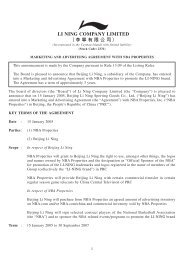Annual Report - Li Ning
Annual Report - Li Ning
Annual Report - Li Ning
- TAGS
- annual
- ning
- www.lining.com
Create successful ePaper yourself
Turn your PDF publications into a flip-book with our unique Google optimized e-Paper software.
Management Discussion and Analysis (Continued)<br />
RESULTS REVIEW<br />
Key Financial Indicators<br />
Key financial indicators of the Group for the year ended 31 December 2006 are summarised as follows:<br />
Year ended 31 December Change<br />
2006 2005 (%)<br />
(Reclassified–<br />
Note 7)<br />
Items of income statement (audited)<br />
(All amounts in RMB thousands unless otherwise stated)<br />
Turnover 3,180,543 2,450,536 29.8<br />
Gross profit 1,508,552 1,126,189 34.0<br />
Operating profit 402,518 271,497 48.3<br />
EBITDA (Note 1) 438,407 296,435 47.9<br />
Profit attributable to equity holders 294,846 186,800 57.8<br />
Basic earnings per share (RMB cents) (Note 2) 28.65 18.25 57.0<br />
Selected financial ratios (audited)<br />
Gross profit margin (%) 47.4 46.0<br />
Operating profit margin (%) 12.7 11.1<br />
Margin of profit attributable to equity holders (%) 9.3 7.6<br />
Effective tax rate (%) 26.4 31.1<br />
Return on equity holders’ equity (%) 23.0 17.2<br />
Debt to equity holders’ equity ratio (Note 3) 0.53 0.35<br />
Average inventory turnover (days) (Note 4) 70 84<br />
Average accounts receivable turnover (days) (Note 5) 55 44<br />
Average trade payables turnover (days) (Note 6) 67 68<br />
Notes:<br />
1. EBITDA refers to earnings before interest, tax, depreciation and amortisation.<br />
2. The calculation of basic earnings per share is based on the profit attributable to equity holders for the year ended 31 December 2006 of RMB294,846,000 (2005:<br />
RMB186,800,000) and the weighted average of 1,029,030,000 ordinary shares in issue during the year less shares held for the Restricted Share Award Scheme (2005:<br />
1,023,827,000 shares).<br />
3. The debt to equity holders’ equity ratio is based on total liabilities divided by equity holders’ equity as at 31 December.<br />
4. The calculation of average inventory turnover (days) is based on the average of opening and closing inventory balances divided by the cost of sales and multiplied by<br />
365 days.<br />
5. The calculation of average accounts receivable turnover (days) is based on the average of opening and closing balances of accounts and notes receivable divided by<br />
turnover and multiplied by 365 days.<br />
6. The calculation of average trade payables turnover (days) is based on the average of opening and closing balances of trade payables divided by total purchases and<br />
multiplied by 365 days.<br />
7. See note 2.23 to the consolidated financial statements.<br />
17 >


